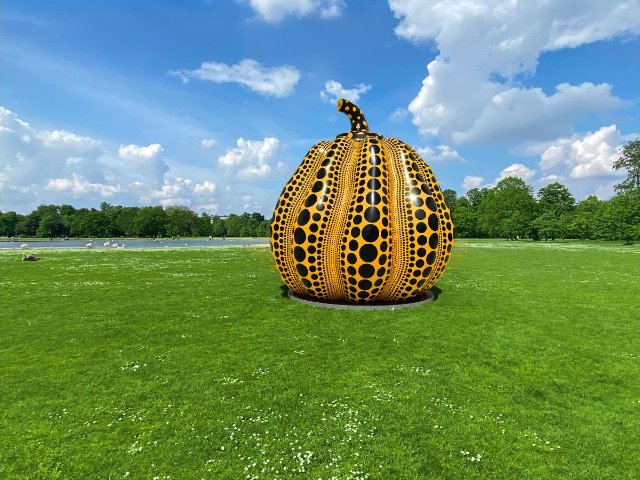Yayoi Kusama at Serpentine Gallery
Giant Bronze Pumpkin
By: Serpentine - May 30, 2024
Pumpkin (2024) marks a return to Serpentine for Kusama which was the location of her first retrospective exhibition in Britain in 2000. This major survey included paintings, collages, watercolours, sculptures, documentation of performances and films, all of which explored Kusama’s obsessions with dots, nets, food and sex.
The work on view in Kensington Gardens is Kusama’s tallest bronze pumpkin sculpture to date, standing at 6 metres tall and 5.5 metres in diameter. Installed prominently by the Round Pond, Pumpkin (2024) can be seen from a wide variety of viewpoints and perspectives creating an intriguing dialogue with the surrounding environment of the Park.
Known for her immersive installations, large-scale sculptures and intricate paintings, Yayoi Kusama often features kabocha, or pumpkin, in her work. Since 1946 Kusama’s pumpkins have taken many forms, colours and shapes, but their surfaces are consistently covered in the artist’s signature repeating polka dot pattern.
Kusama’s relationship to the kabocha is rooted in her childhood: the artist’s family cultivated the plant’s seeds, and their home was surrounded by fields of this squash. Pumpkins frequently appear as stand-ins for self-portraits. Kusama admires them for their everyday quality, hardiness, and unique, frequently humorous forms.
Yayoi Kusama said: “I am sending to London with love my giant pumpkin. Since my childhood pumpkins have been a great comfort to me, they are such tender things to touch, so appealing in colour and form. They are humble and amusing at the same time and speak to me of the joy of living.”
Bettina Korek, CEO, and Hans Ulrich Obrist, Artistic Director, Serpentine, said: “It is an honour to present this work by Yayoi Kusama in Kensington Gardens. Her signature pumpkins have become a landmark motif for the artist, and this project is a reunion for Kusama and Serpentine: her first major survey exhibition in Britain was staged in our galleries in 2000. As always, we are deeply grateful to The Royal Parks for their collaboration, and to all our supporters whose generosity enables Serpentine’s public art programme to connect artists and audiences beyond gallery walls.”
The artist’s sculptures have been installed in museums and galleries around the world, and various outdoor spaces, including parks, gardens and at the seaside. Since 1994, a yellow and black pumpkin is permanently on display at the Benesse Art Site Naoshima – an island in Japan’s inland sea dedicated to displaying art within nature.
Since it launched in 1970, Serpentine has had a long-standing commitment to bringing art out of the traditional gallery context and into the surrounding landscape, offering an opportunity for artists to engage with the immediate environment of Kensington Gardens.
Blow Up ‘71, the first summer show of 1971 featured a week-long outdoor exhibition of inflatables, flying sculpture, and ‘art sports’ in the Royal Parks.
Further exhibitions presented both in the park and at Serpentine include Henry Moore (1978) and Anthony Caro (1984). Sculptures exclusively featured in the Park included Denys Short (1973), John Hoskin (1975), Alfred Dunn (1976), Eduardo Paolozzi (1987), Ron Haselden (1990) and Tony Smith (1996).
Serpentine commissions of public artworks have ranged from a permanent installation of a stone circle and benches by Ian Hamilton Finley for the 1996 exhibition Inside Out.
In recent years, public art has emerged as a central strand of Serpentine’s programme. Major presentations include Anish Kapoor’s Turning the World Upside Down (2010), featuring four works, including his iconic Sky Mirrors, placed in locations across the park, Fischli/Weiss’s sculpture Rock on Top of Another Rock (2013), Betrand Lavier’s Fountain (2014): and Lee Ufan’s Relatum – Stage (2018-19). In 2018, Christo and Jeanne-Claude’s monumental London Mastaba was installed in the Serpentine Lake and marked their first major public artwork in the UK and the final outdoor artwork completed in Christo’s lifetime. Jakob Kudsk Steensen’s augmented reality project The Deep Listener (2019), Sofia Al Maria’s commission Taraxos (2021) and Alexandra Daisy Ginsberg’s Pollinator Pathmaker (2022 – 2023) have brought a younger generation of artist’s commissions to the park.
Kusama’s Pumpkin is the latest in a long-standing series of remarkable public presentations in The Royal Parks since Serpentine’s foundation in 1970 which includes the recently inaugurated STRIP-TOWER (2023) by German luminary Gerhard Richter currently situated on the outdoor plinth at Serpentine South.
As part of the public art programme, Atta Kwami’s mural Dzidz? kple amenuveve (Joy and Grace) (2021-22) has been extended to 30 September 2024, and remains on display at Serpentine North.
The Serpentine Pavilion is a yearly pioneering commission, which began in 2000 with Dame Zaha Hadid. It features the first UK structures by some of the biggest names in international architecture. This year, Seoul-based Korean architect Minsuk Cho and his firm Mass Studies have been selected to design the 23rd Pavilion. The Archipelagic Void will be on view and activated from 7 June – 27 October 2024 at Serpentine South. The Pavilion has evolved over the years as a participatory public and artistic platform for the Serpentine’s pioneering, interdisciplinary, community and education programmes.

